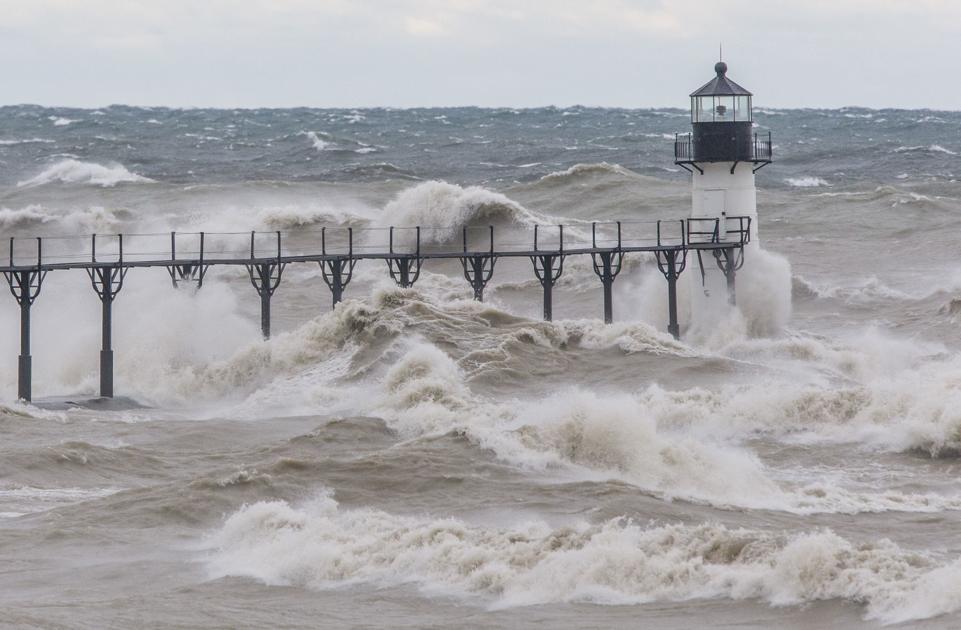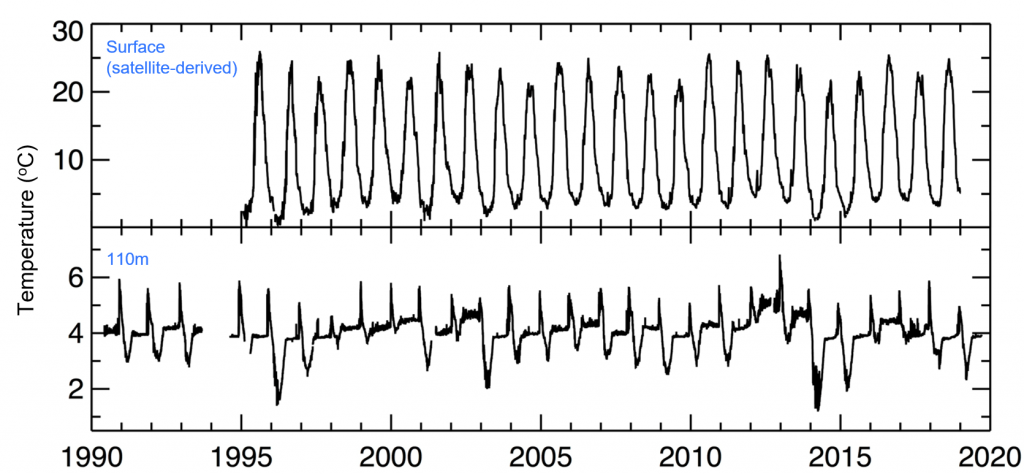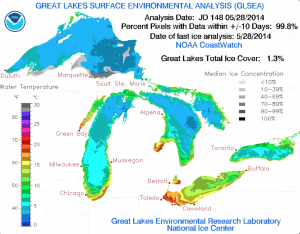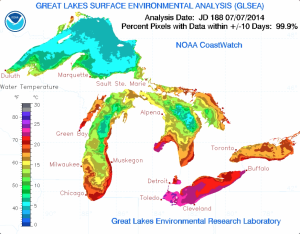Earth change is causing significant impacts on the Great Lakes and the surrounding region. As the largest surface freshwater system in the world, the Great Lakes have an enormous impact, seen and unseen, on the more than 34 million people who live within their collective basin. Because of their unique response to environmental conditions, Earth’s large lakes are considered by scientists as key sentinels of climate change.

A long-term study published in Nature Communications today from NOAA reveals a warming trend in deepwater temperatures that foreshadows profound ecological change on the horizon. While less visible than the loss in ice cover and increasing lake surface temperatures, this latest index of climate change adds to the growing evidence of climate change impacts in the region.
Using a 30-year dataset of deep water temperature measurements, NOAA Great Lakes Environmental Research Laboratory scientists investigated how Lake Michigan’s seasonal mixing patterns are being influenced by climate change. As it turns out, what’s happening on the lake’s surface during the summer is actually impacting the lake’s deep waters during the winter.
“We found that this long-term data set not only confirms that Lake Michigan’s deep waters are warming, but also shows that winter is vanishing from them,” said NOAA GLERL’s Eric Anderson, the study’s lead author. As climate change has gradually delayed the onset of cooler autumn weather over the past three decades, the deep waters of Lake Michigan have reflected this change by showing shorter winter seasons.
This key finding may indicate some dramatic changes in the foreseeable future, as an increase in a lake’s overall water temperature can lead to permanent changes in the water’s seasonal mixing patterns. This could eventually alter Lake Michigan’s rate of primary productivity, which would inevitably disrupt the structure of its entire food web — a change that could have negative impacts on fisheries and recreation. “Without high-frequency long-term monitoring of subsurface waters of the world’s deep lakes,” said Anderson, “we will be blind to the impacts of climate change on most of Earth’s fresh surface water.”

Importance of monitoring below the surface
Our ability to collect lake surface data with satellites, buoys, and water samples has come a long way over the past few decades in helping scientists understand how large lakes throughout the world respond to climate change. But since many of them – including the Great Lakes – are several hundred feet deep, those surface measurements don’t tell the whole story of what’s going on beyond the sight of satellites. Deep-water measurements at high temporal frequency are much more rare, especially on the time scale of years or decades.
In the new research, NOAA GLERL analyzes a 30-year, subsurface temperature dataset in order to observe what Lake Michigan’s deep waters are telling us about Earth’s changing climate. The scientists used a long string of high-tech thermometers called a thermistor string, which floats vertically in the water and records temperatures at different depths in the lake. This instrument has been recording water temperatures every hour almost continuously for the past three decades. Lake Michigan is likely the world’s only large lake with this type of long-term observations of water temperatures at depth.
This groundbreaking research examines the lake’s year-round temperature changes throughout the water column, rather than just lake surface temperatures in the summer. “For small, shallow lakes, summer surface temperatures are a reasonable representation of what’s happening to those lakes as a whole,” said Anderson, “but for our largest lakes like Lake Michigan, that’s not always the case.”
You remember 3 weeks ago during the deep freeze…
Subsurface waters in deep lakes can provide an important signal because they integrate conditions across years, providing a “climate memory,” and can help identify the potential for ecological and physical changes throughout the lake.
“One of the most important results of this study is an improved understanding of changes in the subsurface heat content of the Great Lakes,” said study co-author Andrew Gronewold of the University of Michigan School for Environment and Sustainability. “Interestingly, scientists have also been looking at changes in the heat content of oceans to better understand impacts of climate change. This study represents a logical and exciting approach to viewing Earth’s largest fresh surface waters from a similar perspective.”
Upwelling and downwelling explained
Have you ever heard someone say that the water along Illinois’ or Wisconsin’s beaches is colder compared to Michigan’s? How could that even be possible? I mean, the air temperature in Chicago and Benton Harbor in Michigan could be the exact same, but the lake temperatures in these two places could be completely different. Why?
The answer has everything to do with geography.
All water is propelled by the wind. In the Great Lakes region, the dominant winds – called the Prevailing Westerlies – generally move from the west to the east. They travel in this direction because the Earth rotates counterclockwise. Therefore, the Westerlies push lake water away from the western shore and toward the east.
One important characteristic of water is that the colder it gets in temperature, the heavier it gets as well. Warm water is lighter, less dense, which means its molecules are more spread out. Therefore warm water rises to the surface, while cold water sinks to the bottom. Fresh water is at its densest when it is at a cold 39.2°F. This means that the water at the bottom of the Great Lakes – or any lake that extends deeper than the pycnocline (1,000m) – is always going to be 39.2°F! Learn more about lakes, differences between fresh and salt water, and the ocean in this blog post.
When the wind pushes water away from Chicago’s shore, the water it pushed needs to be replaced. At the same time, the water being pushed toward Michigan’s shore needs somewhere to go. This movement of water is called upwelling and downwelling.
Chicago’s shore experiences upwelling, meaning the water being pushed away by the wind gets replaced by the dense cold water from the bottom of the lake. Downwelling is the reverse of this. In Michigan, the warm surface water gets shoved to the bottom, leaving no chance for the cold water at the bottom to rise.
The fluctuation in temperature is greatest between late spring and early fall. In these months, the surface temperatures on Lake Michigan can vary by as much as 15 or 20 degrees between the western and eastern shores. The same goes for any of the other four lakes. During the winter, the lakes’ surface temperatures are pretty much as cold as at the bottom. It’s either frozen (32°F) or just covered in cold dense water. Take a look at these temperature maps produced by the National Oceanic and Atmospheric Association (NOAA).
The first one is from spring of 2014. Notice the warmer surface temperatures beginning in the middle of Indiana on Lake Michigan. They go on past Muskegon.
The same fluctuation can be seen in the summer. The biggest difference is on Wisconsin’s shoreline, between Milwaukee and Green Bay (light green), compared to shoreline north of Muskegon (brown and red). Both of these regions are at basically the same latitude, but the difference in water temperature is up to 15 degrees! This is upwelling and downwelling in full effect.
The trend continues into the fall.
And by winter, the fluctuation subsides and we’re left with a combination of cold dense water and…ice.
Piece in the climate change puzzle
The deep-water conditions of the Earth’s largest lakes are considered a missing piece of the global climate change puzzle. NOAA’s work on Lake Michigan will pave the way for gaining a better understanding of this puzzle piece in the future.
For the millions of people who rely on the freshwater lakes for drinking water, fisheries and more, studying the changes that large lakes are experiencing is essential to maintaining our resilient ecosystems, communities, and economies. [Nature, NOAA, Geographic Society]
Now subscribe to this blog to get more amazing news curated just for you right in your inbox on a daily basis (here an example of our new newsletter).
You can also follow us on Facebook and/ or Twitter. And, by the way you can also make a donation through Paypal. Thank you!

















You’re gonna change the climate when you block the sun for over a decade. Knew y’all were spraying when I was around 24. I’m 39 now, and they are covering the entire sky. I can’t remember if I knew before 24.